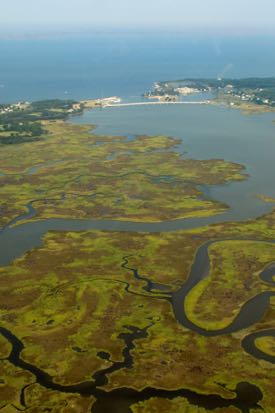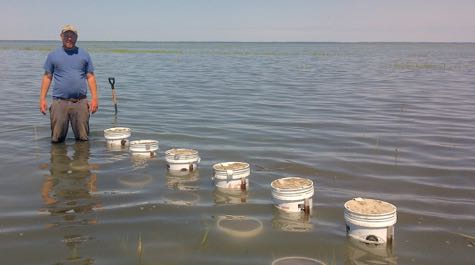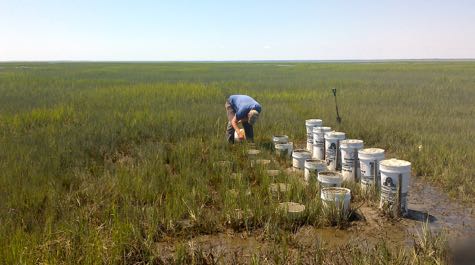Kirwan earns prestigious NSF CAREER Award
Funds will help early-career professor advance research and teaching
Assistant Professor Matt Kirwan of William & Mary’s Virginia Institute of Marine Science has earned a Faculty Early Career Development award from the U.S. National Science Foundation to support his studies of how coastal marshes respond to sea-level rise.
The CAREER award is NSF’s most prestigious award for early-career faculty. Dr. Justin Lawrence, who directs the NSF Geomorphology and Land-use Dynamics program to which Kirwan applied, says the award “recognizes faculty who show potential as academic role models and as leaders in their organization.”
Kirwan’s 5-year, $677,000 award will support field, laboratory, and classroom activities that “build a firm foundation for a lifetime of leadership in integrating education and research.” It includes research support for three post-doctoral fellows and graduate students, as well as six undergraduates.
“I’m excited and grateful for the award,” says Kirwan. “The education component will allow me to work with local community college students and Indian tribes. It means a lot to be able to work alongside families that have lived with the Bay for generations.”
A 2002 graduate of W&M with a B.S. in geology and a minor in mathematics, Kirwan earned his PhD in 2007 at Duke University. Since arriving at VIMS in 2013 from a research assistant professorship at the University of Virginia, he has authored or co-authored 14 articles in leading research journals including Nature and Science. He currently mentors six students and teaches two courses—Principles of Geological Oceanography and Wetland Geomorphology and Ecology. His work on the “ghost forests” shaped by rising seas has been covered by NBC and ABC News, the Associated Press, the Atlanta Journal Constitution, the Houston Chronicle, and scores of other newspapers.
“CAREER awards are extremely competitive,” says VIMS Dean and Director John Wells. “We take great pride in NSF’s recognition of Matt’s accomplishments and future promise. His work to better understand and communicate how coastal marshes respond to rising seas is of utmost importance to the Commonwealth.”
“Matt’s a scientific rock star,” adds Professor Deborah Bronk, who chairs the Physical Sciences Department in which Kirwan works. “His receipt of this award is another example of his stellar research and the benefits it brings to Chesapeake Bay and the nation.”
 The specific goal of the research and teaching activities Kirwan laid out in his successful CAREER proposal is to combine lab and field studies with computer modeling to determine and predict how the carbon stored in coastal marshes will respond to sea-level rise. Chesapeake Bay is home to some of the most extensive marshes in the world.
The specific goal of the research and teaching activities Kirwan laid out in his successful CAREER proposal is to combine lab and field studies with computer modeling to determine and predict how the carbon stored in coastal marshes will respond to sea-level rise. Chesapeake Bay is home to some of the most extensive marshes in the world.
“Coastal marshes sequester about half of all the carbon held in marine environments,” says Kirwan, “but we know very little about how that carbon will respond to rising seas or to construction of levees and other coastal infrastructure.” Carbon buried in marsh sediments contributes little to current global warming, but will increase temperature and ocean acidity if released as carbon dioxide to air and seawater.
Kirwan and his team of students and laboratory technicians will pursue their studies by combing through historical maps, sampling marsh soils, and using what they find to develop and refine computer models to predict how the size and carbon content of coastal marshes will respond to future rises in sea level.
“We’ll use data collected from across the Chesapeake Bay region to develop and test our model,” says Kirwan. “Our ultimate aim is to help land managers evaluate the degree to which marsh migration into drowning uplands will offset losses due to coastal erosion, and to determine how one of the world's largest carbon sinks will respond to climate change.”



